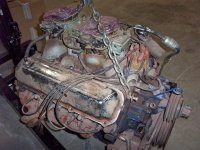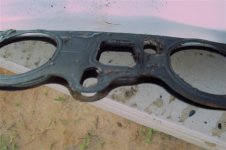The exhaust is clear. Both pipes join into one just before the muffler. One of the things that happens from time to time is the muffler will come off at the point where the two pipes join into one. This just happened and I re-attached it again. Kind of an ongoing problem since putting the engine back in, but I don't think the source of this problem.
Thanks for the information on the crossover vents. I never heard of such a thing, but it's good to know. Now that I know there's a sourse of oil that should be there, I think it will lead to how I'm getting oil into the fuel/air part of the manifold. It makes sense to me that the problem is in that area.
The heads were fine and not milled down. I do not know if the engine has been rebuilt before, but there was no sign of it that was obvious. I think the heads are original and of the proper height. I could be wrong, but don't know how to test this with them on the block.
The bolts might be another, or the main problem. When I took it apart, I just put the bolts into a coffee can and set them aside. When I put it back together, I realized that the bolts were different. All were 9/16 head, but the head design and threads were different. I thought I put them in the right place, but now that I've taken off the intake manifold, I have my doubts.
If the wrong bolts were used, either not long enough, or without the proper head design, could this allow oil to get past the threads? Could enough oil get through to cause my oil issues, but be small enough to give me a solid vacume test? I'm going to buy new bolts and use teflon thread sealant.
The owner of the machine shop where the work was done on the block said that the intake manifolds on those engines have a history of leaking. He said to put on silicone, then let it dry before installing the gasket. Now that the gasket is off, I need to talk to him again and show him the gasket, because it's not what I was expecting. I didn't remember it being three pieces. The metal pan, and the two metal gaskets on either side of the metal pan.
The intake manifold is cast iron, not aluminum.
I might just put it back together with new gaskets and bolts, but hopefully do a better job of sealing everything up, and hope for the best. I hate not finding the problem and knowing for sure where it is.
Could the manifold be cracked and allow oil into the fuel/air passage, but be so small as to not affect the vacume test? I find this hard to believe, but I'm grasping at anything right now.
Thank you,
Eddie


 This lets more than usuall amount of vapours back to the intake manifold fouling the plugs.
This lets more than usuall amount of vapours back to the intake manifold fouling the plugs.





